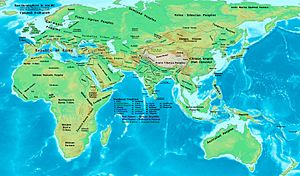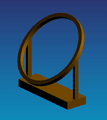2nd century BC facts for kids
| Millennium: | 1st millennium BC |
|---|---|
| Centuries: | 3rd century BC · 2nd century BC · 1st century BC |
| Decades: | 190s BC 180s BC 170s BC 160s BC 150s BC 140s BC 130s BC 120s BC 110s BC 100s BC |
| Categories: | Births – Deaths Establishments – Disestablishments |

The 2nd century BC was a century that started the first day of 200 BC and ended the last day of 101 BC. It is considered part of the Classical period of history.
After having won the Second Punic War, the Roman Republic continued expanding by conquering neighbouring territories. It eventually made Greece part of its empire. It also took the coast of North Africa after destroying the city of Carthage at the end of the Third Punic War. In the east, the Seleucid Empire was forced to make concessions to Rome in order to avoid war. Rome came to dominate the Mediterranean Sea during this period. By the end of the century, its army changed from conscription to a voluntary professional force. These changes were known as the Marian Reforms.
In East Asia, China became very successful under the Han Dynasty. Its empire extended from Korea in the east to Vietnam in the South to the borders of what is today Kazakhstan in the west. The Han also try to get help in fighting the Xiongnu from the Yuezhi people in the west. It is also during this century that the first paper is made in China.
| Millennium | Century | |||||||||
|---|---|---|---|---|---|---|---|---|---|---|
| Before Christ / Before Common Era (BC/BCE) | ||||||||||
| 4th: | 40th | 39th | 38th | 37th | 36th | 35th | 34th | 33rd | 32nd | 31st |
| 3rd: | 30th | 29th | 28th | 27th | 26th | 25th | 24th | 23rd | 22nd | 21st |
| 2nd: | 20th | 19th | 18th | 17th | 16th | 15th | 14th | 13th | 12th | 11th |
| 1st: | 10th | 9th | 8th | 7th | 6th | 5th | 4th | 3rd | 2nd | 1st |
| Anno Domini / Common Era (AD/CE) | ||||||||||
| 1st: | 1st | 2nd | 3rd | 4th | 5th | 6th | 7th | 8th | 9th | 10th |
| 2nd: | 11th | 12th | 13th | 14th | 15th | 16th | 17th | 18th | 19th | 20th |
| 3rd: | 21st | 22nd | 23rd | 24th | 25th | 26th | 27th | 28th | 29th | 30th |
| 4th: | 31st | |||||||||
Images for kids
-
The Rosetta Stone, a trilingual decree recording the coronation of Ptolemy V at Memphis in Egypt.
-
Tomb of Empress Lü in Changling, Xianyang, Shaanxi
-
A silver coin of 1 karshapana of King Pushyamitra Shunga (185-149 BC), founder of the Shunga dynasty.
-
Cleopatra II ruled Egypt in co-operation and competition with her brothers Ptolemy VI and VIII for most of the century.
-
Mural from the tomb of Liu Wu whose principality was at the heart of the Rebellion of the Seven States
-
Emperor Wu of Han was probably the most powerful man in the world at the end of the century
-
Drachm of Mithridates II of Parthia, wearing a bejeweled tiara.
-
Coin of Menander I, the Greek king who ruled most of Northern India (c.150-130) and converted to Buddhism.
-
Posidonius was acclaimed as the greatest polymath of his age.
-
Hipparchus' equatorial ring.
See also
 In Spanish: Siglo II a. C. para niños
In Spanish: Siglo II a. C. para niños


















